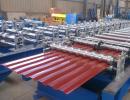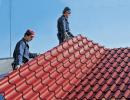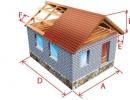How to calculate the angle of inclination of the roof - tips
1.
2.
3.
4.
5.
The process of the construction of the roof can stop, if you do not think about such things in advance of such things as an angle of inclination of the roof and the roofing material used. Since these two indicators have a direct impact on each other, they must be taken into account on a par. Recall that the roofs can have one, two or four slides. Depending on the type, it is necessary to correctly pick up the corners of the rods and materials. In this article, it will be about how to calculate the angle of inclination of the roof.
What affects the corner of the roof of the roof?
The exact angle depends on a number of factors:
- selected roof material;
- climatic characteristics of the region;
- target buildings.
In the case of a two-tie roof and more complex design, not only the choice of climate, but also the purpose of using the attic. For example, if it is non-residential, that is, it is used to store various things, then you do not need to organize a large height of the underpox room. Well, if there is a full attic under the roof, it is not for no high roof with large sloping angles.
But what in the end you should pay attention? On the designer solution, that is, on the project of the building, on the selected roof material, on the amount of precipitation and wind power.
Obviously, for regions with strong winds, it is necessary to build a roof with small angles - it allows you to reduce the load on the rafter system, as well as to avoid the unpleasant effect of the "breaking" of the roof. The same roof design is useful for houses erected in sunny regions with high air temperature and a small amount of precipitation. For regions with severe atmospheric phenomena (rain, hail, snowfall), the angle of inclination of the roof must be large - up to 60 degrees. This allows you to unload the roof and rafters from the burden of snow and water. In addition, due to the rapid removal of precipitation from the surface, the likelihood of roofing material in the joints of the joints is reduced.
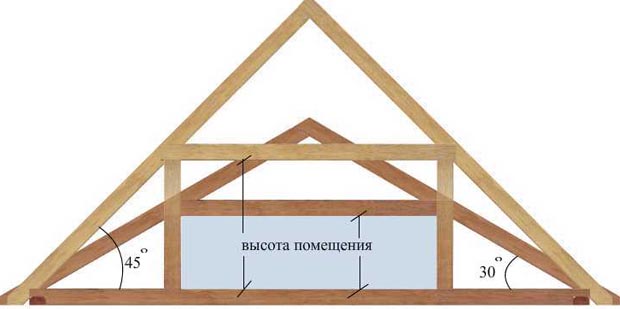
In order to calculate the angle of inclination of the roof, it is necessary to take into account all of the above. As a rule, the angles of slope tilt are considered optimal within 20-45 degrees. Before, it is worth considering the width of the wall, that is, the distance from the start of the skates, since with an increase in this value can significantly reduce the angle, while not limiting the attic in height.
Roofing from metal tileage
It is well known that metal tile is much heavier than other materials. That is why it is worth very carefully to calculate the carrying capacity of the rafted system. It is especially important to take into account the weight of the material and in the regions with strong winds. Dynamic loads have an extremely negative impact on the material and carrying design, it is especially manifested at large roof inclination angles.

For roofs, erected using metal tiles, the average value of the angle of inclination is 22 degrees. According to the observations of professionals, it is such a bias that makes it possible to prevent the accumulation and penetration of moisture at the joints, it is good to distinguish snow and water, and also to resist wind loads. It should be at least 14 degrees. For soft tiles, this figure is 11 degrees, while such a roof requires the organization of a solid crate.
Roofing from professional flooring
This material is tremendous. It has a small weight, simplicity of installation and repair. In addition, consolidate sheets of professional flooring on the crate is very simple. The minimum angle of such a roof is 12 degrees. It is this recommendation that is indicated in the instructions of most material producers.
Roofing from rolled "soft" materials
Such materials include Ontulin, rubberoid, membrane coatings. Depending on the number of layers used to cover the roof, the angle of inclination can range from 2 to 15 degrees. So, for a two-layer roof, a slope is 15 degrees, while a three-layer design allows to cover a flat roof with an angle of inclination of 2-5 degrees.
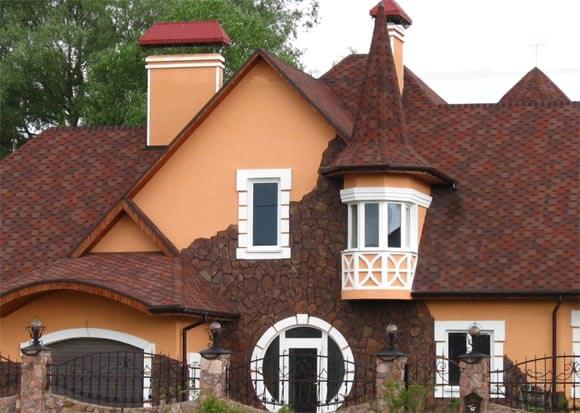
Membrane coatings can be used to erect the roofs of absolutely any configuration regardless of its complexity. So, the angle of inclination of the four-tie roof (individual elements) can be from 2 degrees.
As can be understood from all the above, the selected angle of inclination depends on the master's decision. But at the same time, loads on the carrier design (static and dynamic) are taken into account. It is also important to take into account the type of crate and its step, since these parameters depend on the angle of inclination. For small angles, the shadow step is an average of 35-45 cm.
The angle of inclination of the roof is directly affected by the flow of roofing material. So, the greater angle, the more it is necessary to cover the plane coating.
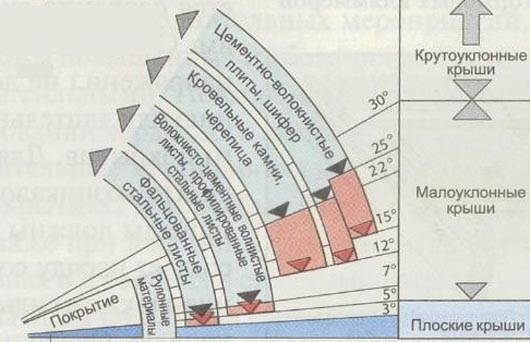
During the selection of roofing material, you can take advantage of the following tips:
- with a small roof slope (up to 10 degrees), the roof can be covered using gravel and stone crumbs. At the same time, the gravel layer is equal to 15 mm, and the crumbs of the stone - 5 mm;
- with more pronounced angles of the inclination of the roof, waterproofing is used using bitumen. For rolled materials, among other things, it is necessary to cover with protective material;
- asbestos-cement sheets and professional flooring require mandatory sealing of seams. All joints are made double.


